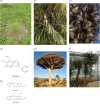Hypoglycemic effects of dracorhodin and dragon blood crude extract from Daemonorops draco
- PMID: 38446324
- PMCID: PMC10917723
- DOI: 10.1186/s40529-024-00415-1
Hypoglycemic effects of dracorhodin and dragon blood crude extract from Daemonorops draco
Abstract
Background: Dragon blood is a red fruit resin from the palm tree Daemonorops draco and is a herbal ingredient used in the traditional Chinese medicine, "Jinchuang Ointment," which is used to treat non-healing diabetic wounds. According to the Taiwan Herbal Pharmacopeia, the dracorhodin content in dragon blood should exceed 1.0%.
Results: Our findings indicate that dracorhodin and dragon blood crude extracts can stimulate glucose uptake in mouse muscle cells (C2C12) and primary rat aortic smooth muscle cells (RSMC). Dracorhodin is not the only active compound in dragon blood crude extracts from D. draco. Next, we orally administered crude dragon blood extracts to male B6 mice. The experimental group displayed a decreasing trend in fasting blood glucose levels from the second to tenth week. In summary, crude extracts of dragon blood from D. draco demonstrated in vivo hypoglycemic effects in B6 male mice.
Conclusions: We provide a scientific basis "Jinchuang ointment" in treating non-healing wounds in patients with diabetes.
Keywords: Blood glucose; Dracorhodin; Dragon blood; Jinchuang ointment; Wound healing.
© 2024. The Author(s).
Conflict of interest statement
The authors declare that they have no competing interests.
Figures






References
LinkOut - more resources
Full Text Sources

